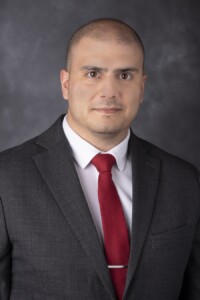2024 Early Career Investigator Grant Recipient — Charles Ishak, PhD
Project Summary
This project will address the unmet clinical need to identify strategies to intercept early-stage ovarian high-grade serous carcinoma (HGSC) and improve HGSC response to immunotherapies in order to improve patient outcomes. Our approach to develop cancer interception strategies is to understand mechanisms of HGSC immune evasion during cancer initiation in order to identify vulnerabilities that can be exploited therapeutically. Our preliminary data suggests that repetitive DNA sequences, derived in part from ancient viral infections, become active in precancerous lesions of the fallopian tube and induce an antiviral response that we describe as ‘viral mimicry’. We hypothesize that active viral mimicry underlies chronic inflammation that selects for cells best suited to evade the immune system before the HGSC tumor begins to form. This project will determine: 1) how repetitive DNA drives chronic inflammation to select for immune evasion and 2) whether we can exploit this process therapeutically to intercept early HGSC and improve HGSC response to immunotherapies. This is important because multiple groups are developing approaches to improve early detection of HGSC. We expect this project to produce new therapeutic options to convert early diagnoses into actionable information that will shift HGSC management towards early-stage interception that will improve cure rates.
This grant was made possible in part by generous donations from The Mike & Patti Hennessy Foundation, and Jennifer Willett in memory of Lynne Willett
Bio
Dr. Charles Ishak is an Assistant Professor within the Department of Epigenetics and Molecular Carcinogenesis and the Department of Gynecologic Oncology and Reproductive Medicine at The University of Texas MD Anderson Cancer Center. Dr. Ishak completed his Postdoctoral Fellow in the laboratory of Dr. Daniel De Carvalho at the Princess Margaret Cancer Centre, University Health Network in Toronto, Canada, and earned his PhD from Western University in the laboratory of Dr. Frederick Dick. Dr. Ishak’s work explores mechanistic connections between tumor suppression and repetitive elements, with a particular focus on how changes to heterochromatin at repetitive elements may contribute towards immune evasion during cancer initiation. This work has earned several awards including the Lucille & Norton Wolf Publication Award in Epigenetics from the Lawson Health Research Institute in Canada. Dr. Ishak is a recipient of a Postdoctoral Fellowship from the Canadian Institutes of Health Research (CIHR) and served as an Associate Faculty member with the Cancer Genomes and Epigenomes division of Faculty Opinions, and currently serves on the CIHR Doctoral Research Awards Peer Review Committee.
The Ishak laboratory explores contributions of repetitive DNA sequences in cancer initiation, progression, and therapeutic response with the overarching goal of improving cancer immunotherapies and developing novel approaches for cancer interception and immunoprevention. To study repetitive elements in cancer, our team unites basic scientists, clinicians, and computational biologists who characterize archived patient tissues and preclinical models to obtain direct insights into human disease. Current projects explore how repetitive elements promote ovarian high grade serous carcinoma (HGSC) initiation. The tumor suppressor gene TP53 encodes the p53 tumor suppressor protein and is mutated as an initiating event in nearly every HGSC and many other cancer types. Recent work implicates p53 in the silencing repetitive elements through mechanisms that remain poorly understood. The lab’s current projects explore the mechanistic relationships between TP53 mutations, chromatin regulation, repetitive elements, and ‘viral mimicry’ responses to dsRNA in HGSC initiation and premalignancy. Our emerging work suggests that contributions of repetitive elements towards HGSC initiation establish therapeutic vulnerabilities that represent potential targets for early cancer interception.
